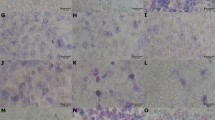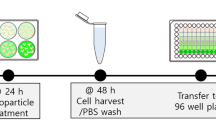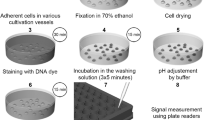Abstract
The sulforhodamine B (SRB) assay is used for cell density determination, based on the measurement of cellular protein content. The method described here has been optimized for the toxicity screening of compounds to adherent cells in a 96-well format. After an incubation period, cell monolayers are fixed with 10% (wt/vol) trichloroacetic acid and stained for 30 min, after which the excess dye is removed by washing repeatedly with 1% (vol/vol) acetic acid. The protein-bound dye is dissolved in 10 mM Tris base solution for OD determination at 510 nm using a microplate reader. The results are linear over a 20-fold range of cell numbers and the sensitivity is comparable to those of fluorometric methods. The method not only allows a large number of samples to be tested within a few days, but also requires only simple equipment and inexpensive reagents. The SRB assay is therefore an efficient and highly cost-effective method for screening.
This is a preview of subscription content, access via your institution
Access options
Subscribe to this journal
Receive 12 print issues and online access
$259.00 per year
only $21.58 per issue
Buy this article
- Purchase on Springer Link
- Instant access to full article PDF
Prices may be subject to local taxes which are calculated during checkout

Similar content being viewed by others
References
Skehan, P. et al. New colorimetric cytotoxicity assay for anticancer-drug screening. J. Natl. Cancer Inst. 82, 1107–1112 (1990).
Lillie, R.H.J. Conn's Biological Stains 9th edn (Williams & Wilkins, Baltimore, 1977).
McCaffrey, T., Agarwal, L. & Weksler, B. A rapid fluorometric DNA assay for the measurement of cell density and proliferation in vitro. In Vitro Cell Dev. Biol. 24, 247–252 (1988).
Monks, A. et al. Feasibility of a high-flux anticancer drug screen using a diverse panel of cultured human tumor cell lines. J. Natl. Cancer Inst. 83, 757–766 (1991).
McLaren, C., Ellis, M. & Hunter, G. A colorimetric assay for the measurement of the sensitivity of herpes simplex viruses to antiviral agents. Antiviral Res. 3, 223–234 (1983).
Kleymann, G. & Werling, H. A generally applicable, high-throughput screening-compatible assay to identify, evaluate, and optimize antimicrobial agents for drug therapy. J. Biomol. Screen 9, 578–587 (2004).
Pittayakhajonwut, P. et al. An anti-herpes simplex virus-type 1 agent from Xylaria mellisii (BCC1005). Tetrahedron Lett. 46, 1341–1344 (2005).
Griffon, G., Merlin, J. & Marchal, C. Comparison of sulforhodamine B, tetrazolium and clonogenic assays for in vitro radiosensitivity testing in human ovarian cell lines. Anticancer Drugs 6, 115–123 (1995).
Pauwels, B. et al. Comparison of the sulforhodamine B assay and the clonogenic assay for in vitro chemoradiation studies. Cancer Chemother. Pharmacol. 51, 221–226 (2003).
Plumb, J., Milroy, R. & Kaye, S. Effects of the pH dependence of 3-(4,5-dimethylthiazol-2-yl)-2,5-diphenyl-tetrazolium bromide-formazan absorption on chemosensitivity determined by a novel tetrazolium-based assay. Cancer Res. 49, 4435–4440 (1989).
Rubinstein, L.V. et al. Comparison of in vitro anticancer-drug-screening data generated with a tetrazolium assay versus a protein assay against a diverse panel of human tumor cell lines. J. Natl. Cancer Inst. 82, 1113–1117 (1990).
Haselsberger, K., Peterson, D., Thomas, D. & Darling, J. Assay of anticancer drugs in tissue culture: comparison of a tetrazolium-based assay and a protein binding dye assay in short-term cultures derived form human malignant glioma. Anticancer Drugs 7, 331–338 (1996).
Perez, R., Godwin, A., Handel, L. & Hamilton, T. A comparison of clonogenic, microtetrazolium and sulforhodamine B assays for determination of cisplatin cytotoxicity in human ovarian carcinoma cell lines. Eur. J. Cancer 29A, 395–399 (1993).
Keepers, Y. et al. Comparison of the sulforhodamine B protein and tetrazolium (MTT) assays for in vitro chemosensitivity testing. Eur. J. Cancer 27, 897–900 (1991).
Huang, H., Shu, S., Shih, J., Kuo, C. & Chiu, I. Antimony trichloride induces DNA damage and apoptosis in mammalian cells. Toxicology 129, 113–123 (1998).
Acknowledgements
We would like to thank Y. Thebtaranonth for his invaluable input.
Author information
Authors and Affiliations
Corresponding author
Ethics declarations
Competing interests
The authors declare no competing financial interests.
Rights and permissions
About this article
Cite this article
Vichai, V., Kirtikara, K. Sulforhodamine B colorimetric assay for cytotoxicity screening. Nat Protoc 1, 1112–1116 (2006). https://doi.org/10.1038/nprot.2006.179
Published:
Issue Date:
DOI: https://doi.org/10.1038/nprot.2006.179
This article is cited by
-
Cell migration, DNA fragmentation and antibacterial properties of novel silver doped calcium polyphosphate nanoparticles
Scientific Reports (2024)
-
Dimerization of the 4Ig isoform of B7-H3 in tumor cells mediates enhanced proliferation and tumorigenic signaling
Communications Biology (2024)
-
Nanoemulsions and nanocapsules loaded with Melaleuca alternifolia essential oil for sepsis treatment
Drug Delivery and Translational Research (2024)
-
Nanoemulsion potentiates the anti-cancer activity of Myricetin by effective inhibition of PI3K/AKT/mTOR pathway in triple-negative breast cancer cells
Medical Oncology (2024)
-
CYB5R3 functions as a tumor suppressor by inducing ER stress-mediated apoptosis in lung cancer cells via the PERK-ATF4 and IRE1α-JNK pathways
Experimental & Molecular Medicine (2024)
Comments
By submitting a comment you agree to abide by our Terms and Community Guidelines. If you find something abusive or that does not comply with our terms or guidelines please flag it as inappropriate.



